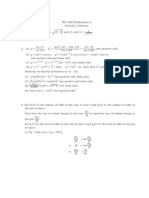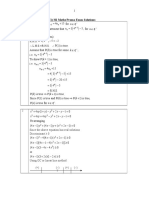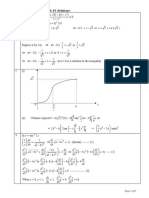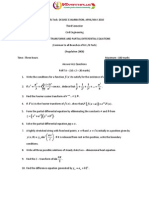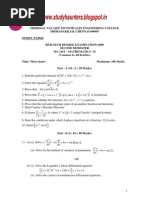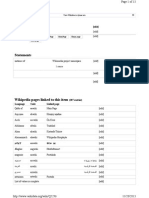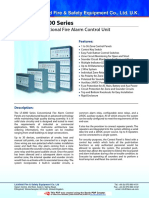m7 REVIEW PDF
m7 REVIEW PDF
Uploaded by
Skyezine Via Kit FoxCopyright:
Available Formats
m7 REVIEW PDF
m7 REVIEW PDF
Uploaded by
Skyezine Via Kit FoxOriginal Description:
Original Title
Copyright
Available Formats
Share this document
Did you find this document useful?
Is this content inappropriate?
Copyright:
Available Formats
m7 REVIEW PDF
m7 REVIEW PDF
Uploaded by
Skyezine Via Kit FoxCopyright:
Available Formats
Math 7 REVIEW
Part I: Problems
1. Using the precise definition of the limit, show that
( )
13 2
5 5
4
lim 1 .
x
x
+ =
[Find the o that works for any arbitrarily chosen positive c and show that it works]
2. Determine the o that will most likely work for any arbitrarily chosen 0 c > in the proof to show that
( )
2
5
lim 7 18.
x
x
=
3. Determine the following limits:
a)
4
2
16
lim
4 8
x
x
x
b)
2 2
0
3( ) 3
lim
h
a h a
h
+
c)
2
2
4 4 3
lim
3 (2 1)
x
x x
x x
+
d)
2
0
tan
lim
2 8
x
x
x x
4. If
2
3
12 , 2
( ) ,
4 8, 2
x x
f x
x x x
<
=
+ + >
determine
2 2 2
lim ( ), lim ( ), and lim ( ).
x x x
f x f x f x
+
5. Let
3, if 2
1
( ) , if 2 .
1
1 , if 2
x
f x x
x
x
<
= s
>
a) Determine the set of all points where f will be continuous.
b) Determine the set of all points where f will be differentiable.
6. Find :
dy
dx
a)
2
2
7
2 1
x
y
x
+
=
b)
2
tan(sin ) y x =
7. Using the guidelines discussed in class (domain, intercepts, symmetry, asymptotes, and sign analysis to
determine intervals of increase/decrease, intervals of concavity), sketch the graph of
3
2
9
x
y
x
=
.
8. If
2
( ) ,
4 1
x
f x
x
=
+
determine lim ( ) and lim ( ).
x x
f x f x
+
9. Using the same guidelines as in #7 above, sketch the graph of
2
( 1)
( 1) 4 1
x x
y
x x
+
=
+ +
.
10. If 4 y x c = + is a tangent line to the curve
3
7 , y x x = determine . c
11. The line 6 4 y x = + is tangent to the graph of g at ( ) 5, (5) . g Determine (5) g and '(5) g .
12. Find the local extremas of ( ) 2sin cos2 f x x x = + in the interval
| ) 0,2 . t
2
13. A particle moves on the -axis x in such a way that its position at time t is given by
5 3
( ) 3 25 60. s t t t t = +
Determine when the particle will be moving to the left.
14. A ball is thrown vertically upward from the ground with an initial velocity of 128 ft/sec. If the positive
direction of the distance from the starting point is up, the equation of motion is
2
16 128. s t t = +
a) Find the average velocity of the ball during the time interval
3 19
4 4
. t < <
b) Find the instantaneous velocity of the ball at
3
4
seconds and at
19
4
seconds.
c) What is happening to the ball at
3
4
seconds and at
19
4
seconds? Why?
d) Find the speed of the ball at
3
4
seconds and at
19
4
seconds.
e) How long will it take the ball to reach its highest point?
f) Determine how high the ball will go.
g) How long will it take the ball to reach the ground?
h) What will be the instantaneous velocity of the ball when it reaches the ground?
15. Find
( )
2
' f
t
if
( )
2
( ) sin cos cos3 f x x x x = + +
16. Determine the equation of the tangent line that satisfies the following conditions.
a) Tangent to the graph of sin , where 0 2 , y x x x t = < < at its point of inflection.
b) Tangent to the curve
3 3
9 at (4,2). x y xy + =
17. Approximate
3
123, to four decimal places, using
a) differentials b) Newtons Method
18. A closed box with a rectangular base is needed to mail an item that requires 288
3
in of space. Because of the
unique shape of the item, the length of the base must be three times its width. Find the dimensions of the box
so that the least amount of material will be used.
19. An open right cylinder is inscribed in a sphere of radius 5 meters. Determine the dimensions of the cylinder
that will give maximum surface area.
20. A water trough 10 feet long has a cross section in the shape of an inverted equilateral triangle with an altitude
of 2 feet. Due to a crack at the bottom of the trough, water is leaking out at the rate of
3
1 ft /hour.
a) Determine the rate at which the height of the water is changing when the depth of the water is 1 feet.
b) Determine the rate at which the height of the water is changing when the trough contains
3
10 ft of water.
21. Evaluate:
a)
3 3 2
(3 4) 3 x x dx
+
}
b)
9
1
3
10
x
dx
x
}
22. If
2
3
0
( ) 1 8 ,
x
F x t dt = +
}
find '(1). F
23. Determine
0
2
sin
.
1
x
d dt
dx t
}
24. If
2
"( ) , '(0) 7, and (0) 2, find ( ). G x x G G G x = = =
3
25. Approximate
4
0
1
,
16
dx
x +
}
with four subintervals, using
a) Trapezoidal Rule b) Simpsons Rule
26 Given the region bounded by
3 2
3 3 y x x x = + and
2
1. y x =
a) Find the area of the above region.
b) Find the volume of the solid generated when the region, where1 4 x s s , is rotated about the -axis. y
27. Find the average value of ( ) sin f x x = on the closed interval
2
0, .
t
(
28. Given the region in the first quadrant bounded by 1 y x = + and
3
1. y x = +
a) Find the volume of the solid generated when this enclosed region is revolved about the x -axis.
b) Set up, but do not integrate, an integral expression in terms of a single variable for the volume of the solid
when the region is revolved about the line 2. x =
29. Find the length of the arc of the curve
2
3
y x = from (1, 1) to (8, 4).
(For #30, 31, and 32) Set up, but do not integrate, an integral that would be used to find the
30. Volume of a solid S, where the base of S is a semi-circular disk described by
{ }
2 2
( , ): 4, 0 . x y x y x + s >
Cross sections of S perpendicular to the -axis x are semicircles with diameters on the base.
31. Volume of the solid generated by revolving about the -axis x the region bounded by
2
1 y x = + and the line
3. y x = +
32. Work done in pumping all the water over the top of a right circular conical tank of altitude 18 feet and radius
6 feet. The tank is full of water weighing
3
62.5 lb/ft .
________________________________________________________________________________________________________
(Answers to Part I)
1. Want to find 0 o > such that
( )
13 2
5 5
1 x c + < whenever 0 4 . x o < <
( )
13 8 2 2 2
5 5 5 5 5
1 4. x x x + = =
So we want
2
5
4 x c < whenever 0 4 x o < < . This will be true if and only if
5
2
4 . x c <
Take
5
2
. o c = If
5
2
o c = and 0 4 , x o < < then
( ) ( )
13 8 5 2 2 2 2 2
5 5 5 5 5 5 5 2
1 4 . x x x o c c + = = < = =
Therefore,
( )
13 2
5 5
1 x c + < whenever 0 4 x o < < , and so
( )
13 2
5 5
4
lim 1
x
x
+ = by precise
n
def of the limit.
2. minimum of { }
11
1,
c
3. a) 8 b) 6a c) 0 d)
1
8
4.
2 2 2
lim ( ) 8; lim ( ) 8; lim ( ) does not exist
x x x
f x f x f x
+
= =
5. a) ( ) ( ) ( ) 2 2,1 1, + b) ( ) ( ) ( ) ( ) , 2 2,1 1,2 2, +
6. a)
( ) ( )
3 1
2 2
2 2
15
7 2 1
x
x x
+
b)
( )
2 2
sin2 sec sin x x
(
4
7.
Domain: ( ) ( ) ( ) - ,-3 -3,3 3,
Intercept: (0,0)
Symmetry with respect to origin
VA at -3, 3 x x = = ; slant asymptote at y x = ;
Crossover of slant asymptote at 0 x =
Increasing on
( ) ( )
- ,-3 3 and 3 3,
Decreasing on
( )
( )
( )
-3 3,-3 , -3,3 , and 3,3 3
Local max at -3 3; x = loc min at 3 3; x =
HPI at 0 x =
CD on ( ) , 3 (0,3); CU on ( ) ( ) -3,0 3,
PI at 0 x =
8.
2 2
1 1 1 1
lim ; lim
2 2
4 1 4 1
x x
x x
x x
+
+ +
= =
+ +
9.
Domain: ( ) ( ) - ,-1 -1,
Intercept: (0,0)
No symmetry
Hole at -1 x =
No VA
HA at
1 1
2 2
- ; ; y y = = no crossovers
Increasing on ( ) - ,-1 and (-1, );
no local extremas
CU on ( ) - ,0 ; CD on ( ) 0, ; PI at (0,0)
10. 2, 2 c = 11. (5) 26; g'(5) 6 g = =
12. loc max at
( ) ( )
3 5 3
6 2 6 2
, & , ;
t t
loc min at
( ) ( )
3
2 2
,1 & , 3
t t
13. 1 2 t < < 15. 3 16. a) 2 y x t = b)
5
4
3 y x =
14. a) 40 ft/sec b)
( )
3 19
4 4
( ) 104 ft/sec; 24 ft/sec v v = = c) going up at
3
4
t = secs; going down at
19
4
t = secs
d)
( )
3 19
4 4
( ) 104 ft/sec; 24 ft/sec v v = = e) 4 sec f) (4) 256 ft s = g) 8 sec h) -128 ft/sec
17. 4.9733 18. 4 x 12 x 6 19.
5 2
radius= ;
2
height=5 2
20. a) decreasing at
3
20
ft/hr b) decreasing at
4
3
20
ft/hr
21. a)
( )
2
3
1
6
3 4 x C
+ + b) 68 22. 6 23. secx 24.
4
1
12
7 2 x x + +
25. a) 0.22325 b) 0.22313 26. a)
253
12
sq. units b)
414
5
t cu. units 27.
2
t
28. a)
29
42
t cu. units b)
1
3
0
2 (2 ) ( 1) ( 1) V x x x dx t ( = + +
}
29. 7.6 30.
( )
2
2
0
4
2
V x dx
t
=
}
31. ( ) ( )
2
2
2
2
1
3 1 V x x dx t
(
= + +
(
}
32. ( )( ) ( )
18
2
1
9
0
18 62.5 W y y dy t =
}
5
Part II: Multiple Choice
1. If at a certain point '( ) 0, f x = which statement concerning the point is always correct?
(A) It is either a relative maximum or a relative minimum.
(B) It is a point of inflection.
(C) It is a point at which the tangent line is parallel to the x -axis.
(D) It is a point at which the tangent line is parallel to the y -axis.
(E) None of these
2. If, for all values of , '( ) 0 and "( ) 0, x f x f x < > which of the following curves could be part of f ?
A)
B)
C)
D)
E)
3. For the function f defined in the adjacent figure,
At which of the points below is "( ) 0? f x s
I) A II) B III) C IV) D V) E VI) F
(A) I and IV only (B) II and III only
(C) II, III, & V only (D) VI only
(E) none of these
y
D -
E -
C - x
B - A- F -
4. The radius of a sphere is increasing at the rate of 2 inches per second. When the radius is 10inches, its volume
is increasing at the rate (in cubic inches per second) of
(A) 800t (B) 80t (C) 3200t (D) 40t (E) none of these
5.
The set of all number(s) c in ( ) 1,3 satisfying the conclusion of the Mean Value Theorem (for derivatives) for the
function
2
( ) 5 3 1 f x x x = + on the interval
| |
1,3 is
(A)
3
2
`
)
(B)
3
10
`
)
(C) { } 2 (D)
3
,2
10
`
)
(E) none of these
6
6.
y
'( ) y f x =
x
-2 3
Let f be a function whose domain is the open interval ( 3,4) and let the derivative of f have the graph shown
in the figure above. The function f is decreasing on which of the following intervals?
(A) (-3,-1) and (2,4) (B) (-2,0) and (3,4) (C) (-3,-2) and (0,3)
(D) (-1,2) only (E) (0,3) only
7. Referring to the graph of '( ) y f x = in problem #6 above, f will have a point of inflection at
I. 2 x = II. 1 x = III. 0 x = IV. 1 x = V. 3 x =
(A) I, III, & V (B) II & IV (C) II only (D) III only (E) none of these
8.
The area of the region bounded by 2cos y x = , tan y x = , and the -axis y can be found by
(A)
( )
4
0
2cos tan x x dx
t
}
(B)
( )
2
0
2cos tan x x dx
t
}
(C)
4
0
(tan 2cos ) x x dx
t
}
(D)
2
0
(tan 2cos ) x x dx
t
}
(E) none of these
9.
The volume of the solid generated by revolving about the line 1 x = the region bounded by
3
y x = and the
lines 0 x = and 8 y = can be found by
(A)
2
3
0
2 ( 1)(8 ) V x x dx t = +
}
(B)
2
3
0
2 ( 1)(8 ) V x x x dx =
}
(C)
8
3
0
2 ( 1)( 1) V x x dx t = +
}
(D)
8
3
0
( 1)( 2) V x x dx t =
}
(E) none of these
10. The work done when a particle moves along the x -axis from 1 x = to 3 x = under the action of a force ( ) f x
pounds and x feet from the origin, where
2
( ) (2 1) , f x x = + is
(A) 316ft-lb (B)
316
3
ft-lb (C)
158
2
ft-lb (D)
158
3
ft-lb (E) none of these
-------------------------------------------------------------------------------------------------------------------------------------------
(Answers to Part II)
1. C 2. E 3. C 4. A 5. C 6. C 7. B 8. A 9. A 10. D
You might also like
- 2008 h2 Math Prelim p1 (Solns)Document19 pages2008 h2 Math Prelim p1 (Solns)Utsav NiroulaNo ratings yet
- MATH1151 Final Exam ReviewDocument3 pagesMATH1151 Final Exam ReviewtravissaronNo ratings yet
- 2014 H2 Maths Prelim Papers - NJC P1 SolutionDocument13 pages2014 H2 Maths Prelim Papers - NJC P1 Solutioncherylhzy0% (4)
- MATH Evaluation 6 - EDGEDocument8 pagesMATH Evaluation 6 - EDGEAchilles Aldave100% (2)
- MA1505 Tutorial Solution 1Document6 pagesMA1505 Tutorial Solution 1Bilguun BatboldNo ratings yet
- Cape Pure Mathematics Unit 2module 1: Complex Numbers and Calculus IiDocument20 pagesCape Pure Mathematics Unit 2module 1: Complex Numbers and Calculus IiCarlon BairdNo ratings yet
- Engineering Mathematics I Question Bank With Answer KeyDocument10 pagesEngineering Mathematics I Question Bank With Answer KeyKuru KshetranNo ratings yet
- Site Acceptance Test Report For 33Kv Cable: Project: Construction of 306 Villas - Al SaadDocument3 pagesSite Acceptance Test Report For 33Kv Cable: Project: Construction of 306 Villas - Al SaadJayaprakash M P100% (1)
- Text 1b emDocument13 pagesText 1b emkrishNo ratings yet
- UDPG1673 - Tutorial 7 - 201601Document4 pagesUDPG1673 - Tutorial 7 - 201601chinNo ratings yet
- ClassXII Topper Sample Paper 50Document26 pagesClassXII Topper Sample Paper 50Mohit SharmaNo ratings yet
- Review For Unit 3 - Chapter 3 Part 2: Sin Xisthesameas (Sinx) Know The Unit Circle!!Document16 pagesReview For Unit 3 - Chapter 3 Part 2: Sin Xisthesameas (Sinx) Know The Unit Circle!!Ian StantonNo ratings yet
- Info Booklet, Revised 2011Document27 pagesInfo Booklet, Revised 2011ordinanceNo ratings yet
- Universiti Tun Hussein Onn Malaysia: This Examination Paper Consists of 5 PagesDocument13 pagesUniversiti Tun Hussein Onn Malaysia: This Examination Paper Consists of 5 PagesCM Zain CrcoNo ratings yet
- Add Maths DifferentiationDocument44 pagesAdd Maths DifferentiationShakynna ParasinNo ratings yet
- Cal Review1Document4 pagesCal Review1Carlos MotosNo ratings yet
- C4 Integration WorksheetDocument25 pagesC4 Integration WorksheetMaidah YaqoobNo ratings yet
- Blue Print: Class Xii Maths: Model Question PaperDocument14 pagesBlue Print: Class Xii Maths: Model Question Paperapi-243565143No ratings yet
- REVIEW - QuadraticsDocument2 pagesREVIEW - QuadraticsPranav KNo ratings yet
- 2014 2 SARAWAK SMKStJoseph Kuching MATHS QADocument11 pages2014 2 SARAWAK SMKStJoseph Kuching MATHS QASK100% (3)
- MA1505 Tutorial 1 QuestionsDocument4 pagesMA1505 Tutorial 1 QuestionsBilguun BatboldNo ratings yet
- Https Doc 00 7g Apps Viewer - GoogleusercontentDocument7 pagesHttps Doc 00 7g Apps Viewer - GoogleusercontentVignesh RavishankarNo ratings yet
- Pre-Calculus Math 40s Standards Test - Trigonometry I QUESTIONSDocument17 pagesPre-Calculus Math 40s Standards Test - Trigonometry I QUESTIONShmdniltfiNo ratings yet
- DocumentDocument9 pagesDocumentDavid RodriguezNo ratings yet
- Calculus I (1,2,3,4) RevisionDocument6 pagesCalculus I (1,2,3,4) RevisionYousra AzabNo ratings yet
- TJC JC 2 H2 Maths 2011 Mid Year Exam SolutionsDocument12 pagesTJC JC 2 H2 Maths 2011 Mid Year Exam SolutionsjimmytanlimlongNo ratings yet
- Bab Integral (Sma)Document44 pagesBab Integral (Sma)ristaNo ratings yet
- Linear Algebra Final ExamDocument3 pagesLinear Algebra Final ExamDaniel TarantinoNo ratings yet
- Answers Are You Ready For CalculusDocument6 pagesAnswers Are You Ready For CalculusKevin HsiehNo ratings yet
- Ajc h2 Math p1 SolutionsDocument15 pagesAjc h2 Math p1 SolutionsjimmytanlimlongNo ratings yet
- HCI 2008 Promo W SolutionDocument12 pagesHCI 2008 Promo W SolutionMichael CheeNo ratings yet
- Chapter 14 IntegrationsDocument10 pagesChapter 14 Integrationsfazz_zalniaNo ratings yet
- Precalculus Review: For Problems 1 Through 3, Let P (1, 3) and Q (5, - 3)Document7 pagesPrecalculus Review: For Problems 1 Through 3, Let P (1, 3) and Q (5, - 3)shannonhu519No ratings yet
- Diagnostic Exam Reviewer - Differential CalculusDocument5 pagesDiagnostic Exam Reviewer - Differential CalculusHarold MangaNo ratings yet
- Exam Review 11 Q&ADocument5 pagesExam Review 11 Q&Aesn_kNo ratings yet
- Chapter 2: Trigonometric FunctionsDocument10 pagesChapter 2: Trigonometric FunctionsSaidin AhmadNo ratings yet
- MCV 4U1 Exam Review 1Document52 pagesMCV 4U1 Exam Review 1Eduardo Yépez M.No ratings yet
- Final Exam Set ADocument17 pagesFinal Exam Set AAtikah J100% (1)
- m2 Rev3t - Swokowski - PDFDocument3 pagesm2 Rev3t - Swokowski - PDFSkyezine Via Kit FoxNo ratings yet
- 2010 Set B Paper 3 RVHS Promo (Solutions)Document12 pages2010 Set B Paper 3 RVHS Promo (Solutions)Lim Kew ChongNo ratings yet
- 010RDocument4 pages010RninokargigogoaNo ratings yet
- 17 Exercise Set FeDocument3 pages17 Exercise Set FeMarione Thea RodriguezNo ratings yet
- 2010 AJC Paper 1solDocument6 pages2010 AJC Paper 1solnothingtodo1992No ratings yet
- Precalculus Final ExamDocument6 pagesPrecalculus Final Examgreen286No ratings yet
- 2008 Ext1 PDFDocument3 pages2008 Ext1 PDFBrandi RoseNo ratings yet
- M3 R08 May Jun 10 PDFDocument3 pagesM3 R08 May Jun 10 PDFSuresh RajuNo ratings yet
- Applied CalculusDocument12 pagesApplied CalculusRonald MulindeNo ratings yet
- CLASS - XII-MATHS Diff&Appl of DiffDocument11 pagesCLASS - XII-MATHS Diff&Appl of DiffNICKNo ratings yet
- AE321 - Solutions For Homework 9: F F F GDocument13 pagesAE321 - Solutions For Homework 9: F F F GArthur Ding100% (1)
- Engineering Mathematics II Model Question Paper StudyhauntersDocument3 pagesEngineering Mathematics II Model Question Paper StudyhauntersSriram JNo ratings yet
- Chapter 3-4 Review RevisedDocument4 pagesChapter 3-4 Review RevisedMUHAMMAD ARSALAN ASIF (ARSAL)No ratings yet
- More Trigonometric SubstitutionDocument35 pagesMore Trigonometric SubstitutionArsalan JumaniNo ratings yet
- Chapter 6mm34 CasDocument15 pagesChapter 6mm34 CasEric MoralesNo ratings yet
- Differential CalculusDocument12 pagesDifferential CalculusAngelo Luigi YasayNo ratings yet
- PDFDocument0 pagesPDFPratyush MishraNo ratings yet
- Differentiation Cheat SheetDocument15 pagesDifferentiation Cheat SheetjieboNo ratings yet
- Tutorial 13BDocument2 pagesTutorial 13BSk CreationsNo ratings yet
- MATH Practice With Answer (Besavilla)Document121 pagesMATH Practice With Answer (Besavilla)aj100% (1)
- Trigonometric Ratios to Transformations (Trigonometry) Mathematics E-Book For Public ExamsFrom EverandTrigonometric Ratios to Transformations (Trigonometry) Mathematics E-Book For Public ExamsRating: 5 out of 5 stars5/5 (1)
- De Moiver's Theorem (Trigonometry) Mathematics Question BankFrom EverandDe Moiver's Theorem (Trigonometry) Mathematics Question BankNo ratings yet
- Файл:Nadschmuddin Gotzinski.jpg: expired and its author is anonymousDocument4 pagesФайл:Nadschmuddin Gotzinski.jpg: expired and its author is anonymousSkyezine Via Kit FoxNo ratings yet
- Main Page: Walcome Tae WikipaediaDocument4 pagesMain Page: Walcome Tae WikipaediaSkyezine Via Kit FoxNo ratings yet
- gУчаст�%Document2 pagesgУчаст�%Skyezine Via Kit FoxNo ratings yet
- Main Page: StatementsDocument13 pagesMain Page: StatementsSkyezine Via Kit FoxNo ratings yet
- Kwerrya: Risos Long InternetDocument1 pageKwerrya: Risos Long InternetSkyezine Via Kit FoxNo ratings yet
- Участ�%Document6 pagesУчаст�%Skyezine Via Kit FoxNo ratings yet
- Tables of Contents - 1916 To 2013: Virtual Special IssuesDocument4 pagesTables of Contents - 1916 To 2013: Virtual Special IssuesSkyezine Via Kit FoxNo ratings yet
- Penggalangan DanaDocument1 pagePenggalangan DanaSkyezine Via Kit FoxNo ratings yet
- Itūlau Muamua: Talofa Lava WikipediaDocument1 pageItūlau Muamua: Talofa Lava WikipediaSkyezine Via Kit FoxNo ratings yet
- Thinking in ErlangDocument31 pagesThinking in ErlangSkyezine Via Kit FoxNo ratings yet
- Welcome To Wikipedia,: From Today's Featured Article in The NewsDocument4 pagesWelcome To Wikipedia,: From Today's Featured Article in The NewsSkyezine Via Kit FoxNo ratings yet
- XmerlDocument40 pagesXmerlSkyezine Via Kit FoxNo ratings yet
- Percept ApplicationDocument36 pagesPercept ApplicationSkyezine Via Kit FoxNo ratings yet
- Table Visualizer Application (TV)Document24 pagesTable Visualizer Application (TV)Skyezine Via Kit FoxNo ratings yet
- Reference ManualDocument59 pagesReference ManualSkyezine Via Kit FoxNo ratings yet
- SNMPDocument248 pagesSNMPSkyezine Via Kit FoxNo ratings yet
- Hydraulic Breakers BrochureDocument8 pagesHydraulic Breakers BrochureEndraNo ratings yet
- THE BASIS FOR AN HISTORICO-GEOGRAPHYCAL JWR wHITEHANDDocument18 pagesTHE BASIS FOR AN HISTORICO-GEOGRAPHYCAL JWR wHITEHANDNa Ru MaNo ratings yet
- DPT Name Syllabus: Aakash Test Planner: Daily Practice Test Schedule & Syllabus For Class-XiDocument19 pagesDPT Name Syllabus: Aakash Test Planner: Daily Practice Test Schedule & Syllabus For Class-Xiuddeshya patelNo ratings yet
- Consistency of Standard Cement PasteDocument53 pagesConsistency of Standard Cement PasteLakshay SinghalNo ratings yet
- Effect of Material Particle Size On The Permeability CharacteristicsDocument11 pagesEffect of Material Particle Size On The Permeability CharacteristicsDiego De la sotaNo ratings yet
- Learning Objectives: Linear ProgrammingDocument8 pagesLearning Objectives: Linear ProgrammingSeng SoonNo ratings yet
- PLN RenewablesDocument38 pagesPLN RenewablesEriansa SoganiNo ratings yet
- Keegan, Foster Chapter 2Document11 pagesKeegan, Foster Chapter 2Tianjiao ChaiNo ratings yet
- Myofunctional Evaluation and ExercisesDocument4 pagesMyofunctional Evaluation and Exercisestâm nguyễnNo ratings yet
- Biology 9700 June 2024 Grade Threshold TableDocument2 pagesBiology 9700 June 2024 Grade Threshold TableAli ArmanNo ratings yet
- Developmental Biology: Syllabus: I. InstructorsDocument7 pagesDevelopmental Biology: Syllabus: I. InstructorsKoyaaaMarkNo ratings yet
- Influence of Pediococcus Acidilactici As-1Document7 pagesInfluence of Pediococcus Acidilactici As-1Edison EdisonNo ratings yet
- Textiles Yarn Production: SieglingDocument20 pagesTextiles Yarn Production: SieglingSebastian QuintanaNo ratings yet
- 24kV Distribution TransformerDocument37 pages24kV Distribution TransformermrhomNo ratings yet
- IR SensorDocument5 pagesIR Sensormohammed amaan paNo ratings yet
- CEB 711 - Structural Design II: Semester 2, 2020 2Document32 pagesCEB 711 - Structural Design II: Semester 2, 2020 2Asnil PrakashNo ratings yet
- Manufacturing Process Final ExamDocument10 pagesManufacturing Process Final ExamMuhammad ilhamNo ratings yet
- POGIL - Gene - Expression Translation SDocument8 pagesPOGIL - Gene - Expression Translation Sandrew fortneyNo ratings yet
- Laboratory Fabrication Procedures of A Metal Partial Denture FrameworkDocument4 pagesLaboratory Fabrication Procedures of A Metal Partial Denture FrameworkPadmini ReddyNo ratings yet
- West Tower Condo Vs FpicDocument4 pagesWest Tower Condo Vs FpicBoredpandaNo ratings yet
- With 105N4710 & 105N4760 ControllersDocument3 pagesWith 105N4710 & 105N4760 ControllersHarold ReyesNo ratings yet
- LF-4000 Series: Conventional Fire Alarm Control UnitDocument43 pagesLF-4000 Series: Conventional Fire Alarm Control UnitRandy FajardoNo ratings yet
- 01 Chemical ProcessDocument333 pages01 Chemical ProcessDavid ValladaresNo ratings yet
- AMPLIFY DC5 4 7 SpecDocument9 pagesAMPLIFY DC5 4 7 SpecVictor De AlvaNo ratings yet
- My Thoughts About The Church at Busitema and UgandaDocument15 pagesMy Thoughts About The Church at Busitema and UgandaMUHOOZI DENISNo ratings yet
- Praveen S Muradi: Email Id: MobileDocument3 pagesPraveen S Muradi: Email Id: MobilePraveen S MuradiNo ratings yet
- Ijireeice 18Document3 pagesIjireeice 18creative risersNo ratings yet
- Study Materials: Vedantu Innovations Pvt. Ltd. Score High With A Personal Teacher, Learn LIVE Online!Document21 pagesStudy Materials: Vedantu Innovations Pvt. Ltd. Score High With A Personal Teacher, Learn LIVE Online!Sumit PatelNo ratings yet
- Deformation Analysis of A Gantry Crane During Workload: January 2013Document6 pagesDeformation Analysis of A Gantry Crane During Workload: January 2013'NovarioAdiguna'No ratings yet




